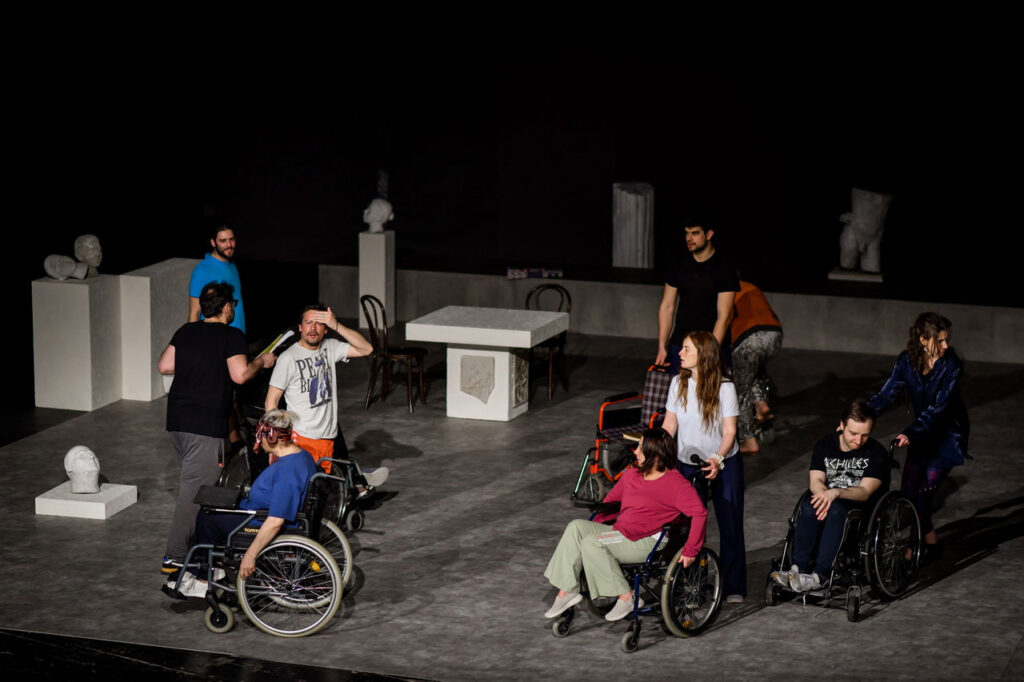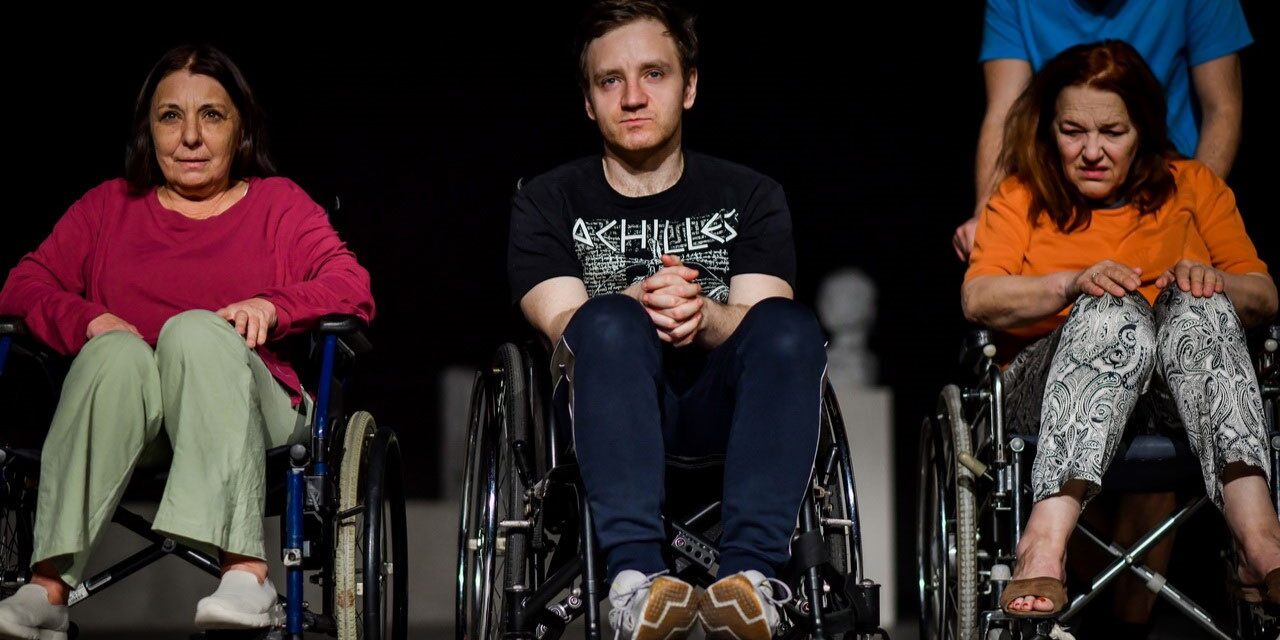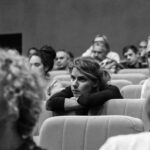Serbian National Theater, Novi Sad, premiere 6th April 2024
For disabled people in Serbia, it is often incredibly challenging to participate in cultural events, so it is noteworthy that an institutional theatre has taken on a theme related to their lives. In A World of Possibilities, director Haris Pašović and the play’s ensemble spent months interacting and learning from individuals with developmental disabilities, their parents, guardians, caregivers, and educators from Novi Sad, Budva, and Sarajevo. This approach to the play’s theme – the daily lives of those with autism and cerebral palsy—is incredibly responsible. The Serbian National Theatre ensemble have drawn on real people and research into their lives to create the characters and events of the show. The actors portray disabled people without any forcedness, exaggeration, imitation, or mockery. Both the verbal and nonverbal characters are performed with great skill, authenticity, and subtlety, avoiding caricatures.
While the actors should be commended for their immense emotional investment and talent, it is necessary to further interrogate the production’s decision to cast non-disabled actors. The phrase “cripping up” was created by UK-based playwright Kaite O’Reilly to describe the act of an able-bodied person playing someone with a disability. The phenomenon has been the subject of continued debate in theatre and film, with it being argued that it can perpetuate stereotypes and deny the opportunity of work to disabled people. In the one hand, the situations represented in A World of Possibilities, and the choice to have the same actors portray both able-bodied and disabled people, would have been difficult to realise if not performed by professional actors. On the other hand, while the play has been well-researched, it could be argued that collaboration between both groups on stage and the integration of disabled people into all aspects of the creative process would have led to a more valuable exchange of experiences. Some examples of successful collaboration and collective action in art include the Novi Sad-based group Per.Art and the Novi Sad regional film festival Seize the Day, which destigmatizes the lives of people with developmental disabilities. On the global theatre scene, the Australian group Back to Back Theatre has built this practice into all of its work, making collaborative theatre that embraces diversity and makes it visible.

World of Possibilities, Serbian National Theatre
A World of Possibilities is constructed of several brief scenes, excerpts from the daily lives of adults with cerebral palsy and autism. The scenes are separated by darkness, often initiated by video projections of shapes, colours, and symbols. Unfortunately, while I believe this wasn’t the intention of the creative team, the subtext of almost every scene is that disabled individuals are a burden on their families. Because of a child with autism, a marriage breaks down, a father gambles and drinks, and a mother dies by suicide. A father takes medication and wistfully dreams of the son who would be a hockey player if he weren’t a wheelchair-user. A mother dedicates their entire life to caring for their child, and that life is filled only with fear, worry, and difficulty. A mother tries to understand who is to blame – perhaps vaccines – for the terrible fate of having a child with autism.
It is indisputable that raising a disabled child can be challenging and isolating, but the play does not go deeply into the world of those who have physical and/or developmental difficulties and mostly portrays them as burdens. The one exception is the emotional relationship between a caregiver in a facility and the wheelchair-using Jela.
Since Pašović’s production features only the most severe cases of autism – those who are either non-verbal or speak very infrequently, rarely react to their environment and rarely form relationships with other people or parents – the production loses the potential to portray autism as a spectrum and show the authentic life stories of people on that spectrum. It also shifts the focus from the inner lives of disabled people to the lives of those who care for them. Also, the play suggests that only a parent and a persistent, self-sacrificing caregiver can love such an individual, Sexual relations are only possible with sex workers. Romantic or friendly love is impossible.
The production’s most touching moment features Matija Močanov, a person with developmental disabilities who plays the piano extraordinarily well. Although the whole episode seems only loosely connected in terms of the dramaturgy at the moment of occurrence, Matija’s virtuosity and the charm with which he enters and exits the stage are undeniable. It is a moment of great joy and energy.
Pašović’s production does a great job of criticizing the system’s indifference towards disabled people. Through the anguish of a mother with a 40-year-old autistic son, we see a Kafkaesque struggle with bureaucracy. Additionally, a meeting between the director of care centre for disabled people and a caregiver confirms that the law is changing slowly and that the system is only effective in the presence of tenacious and compassionate people. In the absence of a more obvious analogy between the title and the story, it is possible to read the title A World of Possibilities as representing the possibilities that committed people and a compassionate community can create.
Halfway through the production we are presented with scene about the trial of a physician who, in Nazi Germany, euthanized people with developmental disabilities on Hitler’s orders. The scene is marked out by its different lighting and acting style. After the trial, the play continues as before. Providing background on how disabled people have been treated historically is necessary and beneficial, however, the question remains of why the director positioned this scene in the middle of the play since it does not affect or change the context of the second part of the show.
The issue of body and corporeality is interestingly touched upon through the production’s poster image, Leonardo da Vinci’s famous drawing Vitruvian Man, the presence of the Renaissance figure of a woman on stage, and the use of video projections of a disintegrating body; this juxtaposition with the bodies of people with developmental difficulties subtly yet clearly indicates that a perfect body is not one with perfect proportions, but one that serves humanity – one that fulfils its function.
Ultimately A World of Possibilities seems to alienate its audience from disabled people, rather than educating and enlightening them about the mistakes we make as a community, or sensitizing them to their problems. The predominant feeling the show evokes is pity rather than empathy. While the show may well have a healing and cathartic effect on the parents of children with autism who finally feel seen and might be enlightening for people who have not previously encountered individuals with this level of disability, others may find it offensive (one viewer with cerebral palsy commenting that this is another repetition of stereotypes where disabled people are represented as people who do nothing outside of occasionally writing poems, and that others’ lives would be simpler without them) or even tasteless, in the case of its ending, in which an autistic person sings Sinan Sakić’s song: “Since I was born, I haven’t had any happiness”. The question remains: who is the show for? Who is it addressing?
Credits:
Author and Director: Haris Pašović // Set design: Ivana Jančić // Music: Dino Šukalo // Piano: Matija Molčanov // Costume: Minja Davidović i Haris Pašović // Choreography: Larisa Lipovac Navojec // Video design: Dino Hujić // Light design: Branislav Milinković // Dialect coach: Dejan Sredojević // Camera and montage: Bojan Kvrgić
Cast: Gordana Đurđević Dimić, Lidija Stevanović, Sanja Ristić Krajnov, Jelena Antonijević, Mina Pavlica, Marija Feldeši, Milan Kovačević, Marko Savković, Vukašin Ranđelović, Aljoša Đidić, Aleksandar Sarapa, Rade Perović
For more information, visit: Snp.org.rs
Further reading: Haris Pašović: “Europe today is a Europe of inequality”
Divna Stojanov is a dramaturg and playwright. She writes mainly for children and young people.








